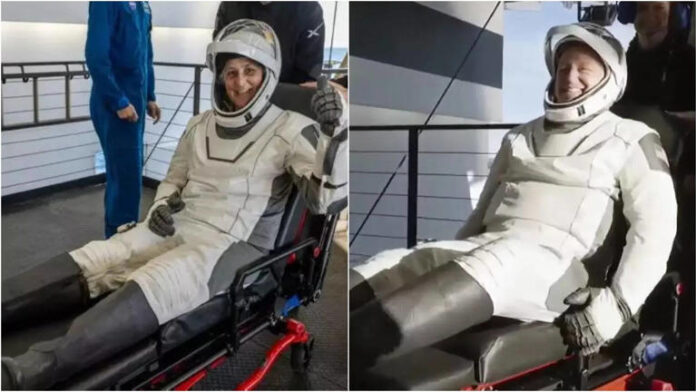After spending an extended period of time in space, astronauts face numerous physical challenges upon their return to Earth. For someone like Sunita Williams, who spent a remarkable 195 days aboard the International Space Station (ISS), re-adjusting to Earth’s environment is no simple task. The changes that astronauts undergo in space are profound, and when they return to Earth, they must contend with the effects of gravity, atmospheric pressure, and the different physiological demands of living on the planet. From puffy faces to weak muscles and blurry vision, here’s a closer look at the challenges Sunita Williams and other astronauts face when they return to Earth.
The Effects of Microgravity on the Human Body
Space offers an environment known as microgravity, where astronauts experience weightlessness. This absence of gravity drastically affects the human body in numerous ways. For starters, the lack of gravity means that fluids, which are typically pulled toward the lower parts of the body, such as the legs and feet, no longer have that gravitational force acting on them. As a result, bodily fluids tend to shift toward the upper body, including the face. This is why many astronauts, including Williams, experience puffiness or swelling in their faces upon returning to Earth.
While this puffy-faced appearance is temporary and will typically subside within a few days as the body readjusts to Earth’s gravity, it’s a constant reminder of how drastically the body adapts to life in space. For Sunita Williams, who spent months in this environment, the puffiness is a common side effect, but it’s not the only adjustment her body must make.
Muscle Weakness and Chicken Legs
Another prominent effect of extended space travel is muscle atrophy. Without the constant gravitational pull exerted on the body, astronauts’ muscles and bones begin to weaken and deteriorate. During her mission, Williams was subjected to microgravity’s impact on her muscles, particularly in the lower limbs. This condition is often humorously referred to as having “chicken legs,” as astronauts experience severe muscle wasting in their legs. Their muscles, which are accustomed to supporting the body’s weight under normal gravity, become much weaker, making walking and standing difficult once they return to Earth.
To counteract this, astronauts like Williams participate in a rigorous exercise regimen while in space, including activities on specialized equipment designed to mimic the effects of gravity. While exercise helps, it cannot fully counteract the loss of muscle strength and bone density that occurs over time. This means that when returning to Earth, astronauts must carefully recondition their bodies, building back their muscle strength and endurance to handle the stress of gravity once again.
Blurry Vision: A Common Issue
One of the lesser-known but highly impactful side effects of extended space missions is vision problems. Many astronauts, including Sunita Williams, have reported blurry or impaired vision upon their return to Earth. This issue is caused by the fluid shift that occurs in space. In microgravity, bodily fluids move toward the head, which increases pressure on the eyes and can lead to changes in vision. The pressure affects the shape of the eyeball and alters the way light is focused, leading to blurry vision.
While Williams’ blurry vision post-space may have been temporary, it’s one of the more complicated issues that space travelers must contend with. The long-term effects on eyesight are still being studied, but it’s clear that prolonged exposure to microgravity can have lasting consequences on the body, including the eyes.
Reconditioning and Adaptation
For Sunita Williams and other astronauts, re-adjusting to Earth’s environment takes time and patience. After returning from the ISS, astronauts undergo a comprehensive medical evaluation and rehabilitation process. They work closely with physical therapists and medical professionals to rebuild their strength and regain muscle function. The process often includes physiotherapy, strength training, and balance exercises to recondition their bodies for life on Earth.
For someone like Williams, who has spent extended periods of time in space, this re-adaptation period is crucial. While the body gradually regains its strength and normal function, astronauts also need to re-acclimatize to Earth’s gravity, which can initially be overwhelming. The sensation of walking under normal gravity after being weightless for so long is disorienting, and the body must recalibrate to handle gravity once again.
Psychological Effects of Re-adjusting to Earth
Beyond the physical challenges, there are psychological effects associated with returning to Earth after a long mission in space. Astronauts can experience something akin to culture shock, as they are suddenly thrust back into an environment that is vastly different from the isolated, high-tech environment of the space station. The transition from the silence of space to the noise and chaos of Earth can be overwhelming. There is also the challenge of reconnecting with friends, family, and the fast-paced world that has changed in their absence.
The psychological stress of adjusting to normal life after space can be just as challenging as the physical effects. Space is a different world, and for astronauts like Williams, returning home is not a simple switch but a gradual process that involves not just physical rehabilitation, but emotional and mental adaptation as well.
Looking Ahead: Continuous Research and Improvements
As space missions continue to push the boundaries of human exploration, the challenges that astronauts like Sunita Williams face upon returning to Earth are a crucial focus of ongoing research. Scientists are studying the long-term effects of microgravity on the human body, and this knowledge will help to develop more effective strategies for counteracting the negative impacts of space travel.
For now, Sunita Williams and other astronauts continue to rely on their training, physical rehabilitation, and support systems to adjust back to Earth’s environment. While the transition back to Earth is not without its difficulties, it is also a testament to human resilience and the capacity to adapt to even the most extreme conditions.
As humanity looks towards the future of space exploration, these studies and adaptations will be essential in ensuring that astronauts can continue to explore the final frontier, while also managing the health and well-being of those who venture into space.




